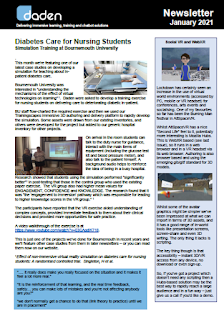The January 2021 edition of our newsletter is out. In this issue:
- Using VR for nurse training - A case-study of our work at Bournemouth University in developing a 3D and VR simulation to help student nurses learn how to manage a diabetic patient on the ward and cope with a related emergency
- VR in the Training Mix - How immersive 3D and VR stack up against more traditional approaches when it comes to addressing the needs of the "3 fidelities" of skills training
- SocialVR Worlds - Our latest experiences inside the emerging Social Virtual Worlds such as AltSpaceVR and MozillaHubs - and what potential they might have for more serious use
- Plus snippets of other things we've been up to in the last 3 months - including links to our presentations at the Giant Health event, and a look at our ever growing library of health training related assets.
You can download and read it here.





